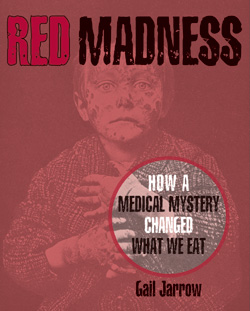‘Red Madness’ Author Gail Jarrow on Solving a Medical Mystery | Up Close
 A potentially fatal disease with a simple cure, pellagra menaced impoverished and vulnerable populations for centuries, causing symptoms such as a striking red rash, insanity and mental confusion, and physical weakness. The roots of pellagra eluded scientists until the early 20th century, when Joseph Goldberger, a physician and epidemiologist, found that the malady was caused by extreme nutritional deficiencies. In the meticulously researched Red Madness: How a Medical Mystery Changed What We Eat (Boyds Mills, 2014), author Gail Jarrow describes how this “medical mystery” unfolded. Jarrow spoke to SLJ about her experiences uncovering this now little-known disease, the scientific method, and her research process.
A potentially fatal disease with a simple cure, pellagra menaced impoverished and vulnerable populations for centuries, causing symptoms such as a striking red rash, insanity and mental confusion, and physical weakness. The roots of pellagra eluded scientists until the early 20th century, when Joseph Goldberger, a physician and epidemiologist, found that the malady was caused by extreme nutritional deficiencies. In the meticulously researched Red Madness: How a Medical Mystery Changed What We Eat (Boyds Mills, 2014), author Gail Jarrow describes how this “medical mystery” unfolded. Jarrow spoke to SLJ about her experiences uncovering this now little-known disease, the scientific method, and her research process.
Why isn’t pellagra more well known? Because it is a medical success story. Although pellagra struck millions of people in the first half of the 20th century, it is so rare today that it has been forgotten. I have met Southerners who heard a grandparent talk about the dreaded disease, but few American doctors today have ever seen a case.
Before 1902, American doctors either had never heard of pellagra or thought it was a disease that didn’t exist in the United States. Yet pellagra had been a scourge without a cure in Europe for hundreds of years.
How did you first hear about pellagra? I stumbled on the subject more than a dozen years ago while researching scurvy for a magazine article. As I looked through books in the Cornell University Library stacks, I noticed one about pellagra. It caught my eye because I had met the author, a local dermatologist and professor of nutritional sciences. Her story about this forgotten disease intrigued me.
 Why did Dr. Goldberger succeed in solving the mystery where so many others hadn’t been able to? I wanted to show the importance of following the scientific method. Early researchers and doctors missed critical clues. When they analyzed the results of tests and experiments, they ignored evidence that contradicted their pet hypotheses. Their tunnel vision led them to the wrong conclusions.
Why did Dr. Goldberger succeed in solving the mystery where so many others hadn’t been able to? I wanted to show the importance of following the scientific method. Early researchers and doctors missed critical clues. When they analyzed the results of tests and experiments, they ignored evidence that contradicted their pet hypotheses. Their tunnel vision led them to the wrong conclusions.
Goldberger approached the mystery with an open mind and was observant enough to see the key to pellagra’s cause. But even after he proved his hypothesis, some scientists and doctors refused to believe him.
Your book is appropriately subtitled “a medical mystery.” Did you feel like a detective as you uncovered the truth? I went back to the beginning—the first report of pellagra in the United States—and worked toward the present. I experienced the twists and turns, errors, and confusion as if I were by the side of the pellagra investigators. The deeper I dug into the past, the more secrets I learned.
You include very powerful images of those afflicted by the disease. How did you find and select these photographs? I found most of them in old government reports and hundred-year-old books written by doctors to educate each other about the “new” disease. Red Madness also contains photographs from the South during the early 1900s.
How did you balance discussing both science and social issues? The medicine, history, and society were intertwined. The answer to the pellagra mystery, as Goldberger realized in 1914, was wrapped up in the South’s history and in the economic and social system after the Civil War. I couldn’t tell the story without including those factors.
What surprised you? I was shocked by the number of people who continued to die many years after Goldberger and his team discovered pellagra’s cause and publicized the ways to prevent it. Although many Southerners were so impoverished that they couldn’t afford a better diet, others simply ignored Goldberger’s advice.
This happens today, too. The medical community constantly warns us about the effect on our bodies of certain behaviors and diet choices. People ignore it, even though the evidence is everywhere.
Add Comment :-
RELATED
The job outlook in 2030: Librarians will be in demand
The job outlook in 2030: Librarians will be in demand
ALREADY A SUBSCRIBER? LOG IN
We are currently offering this content for free. Sign up now to activate your personal profile, where you can save articles for future viewing





